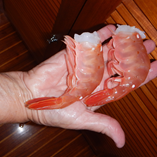A big old blocking high has been sitting off the coast for a couple of weeks keeping the BC coast and SE Alaska generally warmer and drier than normal. It was nice to not have to worry about big storms but the prevailing NW 15-25 winds can build up wave height.
We monitored conditions and the forecast for Dixon entrance, the section of water separating BC from Alaska, which is open to ocean swells looking for the best conditions. Monday and Tuesay, May 18-19, looked optimal. We left our anchorage at Kumealon Inlet on May 18 bound for Brundage Inlet on Dundas Island which borders Dixon Entrance. We were making good time as we had the current with us much of the way.
A few mile short of our turn in to Brundage Inlet, Marcia and I concluded that conditions in Dixon Entrance were good and probably better than they'd be the next morning so Marcia made a call to the US Customs and Border Protection office and obtained permission to use the Foggy Bay anchorage in Alaska before clearing customs. After a 12 hour day, we pulled into Foggy Bay where three other boats had done likewise.
With an "oh-dark thirty" start the next day, we arrived in Ketchikan in the late morning and began our chores and reprovisioning. While there, we visited with David Cohn on the MV Shearwater, a classic style Diesel Duck made by same builder, Seahorse Marine, as our boat.
To get us started with fishing, after Ketchikan we like to head out around (at least partways) Revillagigedo Island (the island on which Ketchikan is located) in Behm Canal. We have some favorite locations where we're usually able to do some crabbing and prawning.  First, though we stopped at the Alaska home of Pete and Brenda. This last year they purchased as a winter home across street from the Green Valley, Arizona winter home our friends the Crowders (they cruised with us in 2011 and 2013). Pete and Brenda live in a
First, though we stopped at the Alaska home of Pete and Brenda. This last year they purchased as a winter home across street from the Green Valley, Arizona winter home our friends the Crowders (they cruised with us in 2011 and 2013). Pete and Brenda live in a home they built on Deep Bay which is on the NW corner of Moser Bay. We anchored in Deep Bay, and dinghied to shore to visit with them and their neighbors.
home they built on Deep Bay which is on the NW corner of Moser Bay. We anchored in Deep Bay, and dinghied to shore to visit with them and their neighbors.
From there it was several days crabbing and prawning around Behm Canal as far as Walker Cove in Misty Fiord National Monument and then back to Klu Bay. After Klu Bay, we slogged up Clarence Strait, into Ernest Sound and up to Thoms Place.
Next, we'll head to Wrangell continuing to fish and checking out some new (to us, anyway) anchorages along the way.





